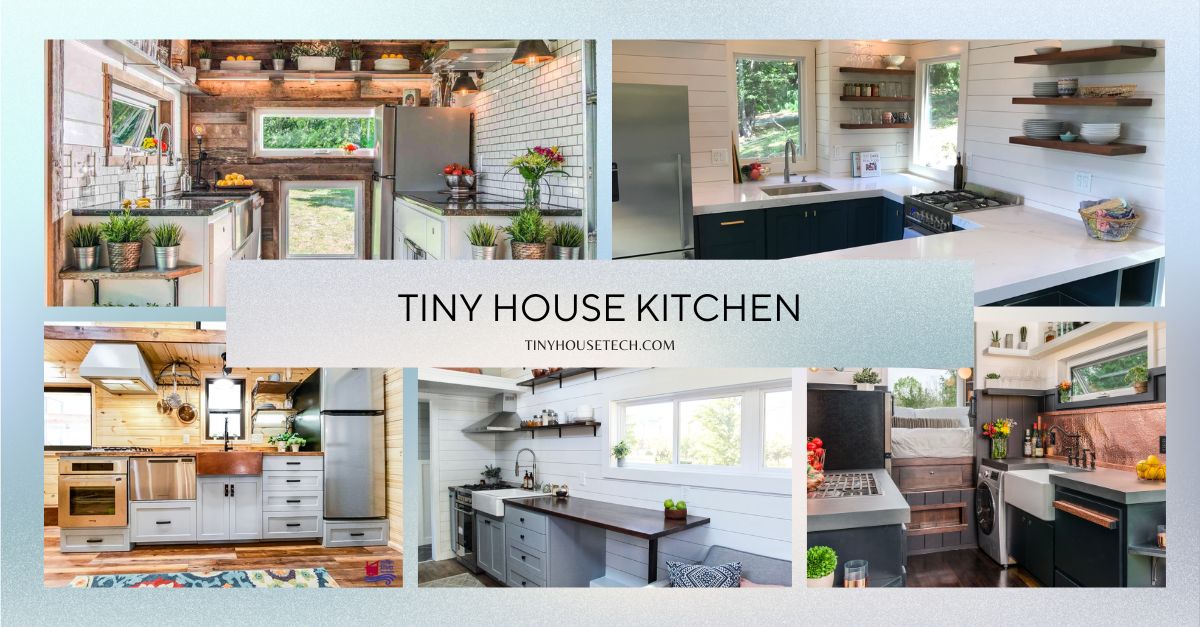Diy
Tiny House Kitchen: Designing for Efficiency and Style

Tiny houses have gained significant popularity in recent years, offering an alternative way of living that embraces simplicity and minimalism. One of the key areas of focus when designing a tiny house is the kitchen. In this article, we will explore the concept of a tiny house kitchen, its benefits, and provide valuable insights and tips on creating a functional and stylish kitchen space within the limited confines of a tiny home.
Introduction to Tiny House Kitchens
Tiny house kitchens are compact, yet highly efficient spaces that prioritize functionality and practicality. Due to the limited square footage in tiny homes, designing a kitchen that maximizes space utilization becomes crucial. A well-designed tiny house kitchen allows for seamless meal preparation, cooking, and storage while ensuring a comfortable and enjoyable culinary experience.
Benefits of a Tiny House Kitchen
Designing a tiny house kitchen offers several advantages. Firstly, it allows for efficient use of resources, reducing energy consumption and minimizing waste. Additionally, a well-designed kitchen in a tiny house promotes a healthier lifestyle by encouraging home-cooked meals and reducing reliance on processed foods. Moreover, a thoughtfully planned kitchen space can enhance the overall aesthetics of the tiny home, making it more inviting and visually appealing.
Design Considerations for Tiny House Kitchens
When designing a tiny house kitchen, certain considerations are essential to make the most of the available space:
1. Maximizing Space Efficiency
In a tiny house kitchen, every square inch counts. Utilizing space-saving techniques such as incorporating foldable or retractable elements, designing built-in storage, and utilizing vertical space is crucial.
2. Utilizing Multi-Functional Furniture
Choosing furniture pieces that serve multiple purposes is a smart way to save space. Opt for convertible dining tables, kitchen islands with built-in storage, or seating options with hidden compartments.
3. Incorporating Smart Storage Solutions
Efficient storage is vital in a tiny house kitchen. Consider installing pull-out cabinets and drawers, utilizing unused wall space with hanging racks, and making use of under-cabinet and overhead storage options.https://youtu.be/e2y2GdSBIwk
Essential Appliances for Tiny House Kitchens
Despite the limited space, a tiny house kitchen can still accommodate essential appliances for daily cooking needs. Here are some space-saving and energy-efficient appliances suitable for tiny house kitchens:
1. Compact Refrigerators and Freezers
Opt for compact refrigerators and freezers that are specifically designed for small spaces. These appliances offer ample storage for perishable items while occupying minimal floor space.
2. Space-Saving Cooking Appliances
Choose cooking appliances that are compact yet versatile. Examples include induction cooktops, combination microwave-convection ovens, and compact dishwashers that can double as storage space when not in use.
3. Energy-Efficient Dishwashers
If space allows, consider installing an energy-efficient dishwasher. Look for compact models that use minimal water and energy, and ensure they integrate seamlessly into the overall kitchen design.
Creative Storage Ideas for Tiny House Kitchens
In tiny house kitchens, innovative storage solutions are key to keeping everything organized and within reach. Here are some creative ideas to maximize storage in a limited space:
1. Vertical Shelving and Hanging Racks
Install open shelves or hanging racks on the walls to store frequently used items, such as pots, pans, and utensils. This not only saves valuable counter space but also adds a decorative element to the kitchen.
2. Pull-Out Cabinets and Drawers
Utilize pull-out cabinets and drawers to make the most of the available space. These allow for easy access to stored items, even in the far corners of the cabinets.
3. Underneath and Overhead Storage Solutions
Make use of the space underneath cabinets and overhead areas by installing hooks, racks, or magnetic strips. These areas can be used to hang mugs, spices, or even knives, freeing up precious counter space.https://youtu.be/AAcYK5Ycdpc
Choosing the Right Materials for Tiny House Kitchen Countertops
In a tiny house kitchen, selecting the appropriate countertop materials is crucial to ensure durability, functionality, and visual appeal. Consider the following factors when choosing countertops:
1. Durable and Compact Options
Opt for durable materials that can withstand daily wear and tear. Compact options like quartz, solid surface, or stainless steel are popular choices for tiny house kitchens due to their durability and low maintenance requirements.
2. Low-Maintenance and Easy-to-Clean Materials
Choose countertop materials that are easy to clean and maintain. Materials like laminate, quartz, or solid surface are stain-resistant and require minimal upkeep, making them ideal for tiny house kitchens.
3. Sustainable and Eco-Friendly Choices
For eco-conscious homeowners, exploring sustainable countertop materials such as bamboo, recycled glass, or reclaimed wood can be a great choice. These materials add a touch of uniqueness and contribute to an environmentally friendly kitchen.
Lighting and Ventilation in Tiny House Kitchens
Proper lighting and ventilation are crucial aspects of any kitchen, including tiny house kitchens. Consider the following strategies for optimizing lighting and ventilation in a limited space:
1. Natural Lighting Strategies
Make the most of natural light by incorporating large windows, skylights, or light tubes. Natural light not only brightens up the space but also creates an illusion of openness, making the kitchen appear larger.
2. LED Lighting Options
LED lights are energy-efficient and provide excellent task lighting for tiny house kitchens. Install LED strips under cabinets, inside drawers, and in other key areas to enhance visibility while saving energy.
3. Efficient Ventilation Systems
To maintain good air quality and minimize cooking odors, invest in a high-quality ventilation system. Consider installing a range hood with an exhaust fan to effectively remove smoke, steam, and odors from the kitchen.
Incorporating Style and Personality into Tiny House Kitchens
Despite the limited space, it’s important to infuse style and personality into a tiny house kitchen. Consider the following tips to add visual appeal and make the kitchen feel like a unique space:
1. Color Palette and Visual Appeal
Choose a color palette that reflects your personal style and complements the overall design of the tiny home. Consider using lighter shades to create an illusion of openness and brightness.
2. Decorative Accents and Accessories
Add decorative elements such as artwork, plants, or decorative kitchenware to inject personality into the space. Just be mindful of not overcrowding the kitchen and maintaining a clutter-free environment.
3. Personalized Touches and Organizational Systems
Customize the kitchen to suit your specific needs by incorporating personalized touches. This can include labeling storage containers, arranging utensils according to usage, or creating an organizational system that works best for you.
Tips for Organizing and Maintaining a Tiny House Kitchen
Keeping a tiny house kitchen organized is essential for maximizing functionality and efficiency. Here are some tips to help you stay organized and maintain your tiny house kitchen:
1. Decluttering and Simplifying
Regularly declutter your kitchen by getting rid of items you no longer need or use. Simplify your cooking utensils, gadgets, and appliances to free up space and create a streamlined kitchen environment.
2. Regular Cleaning and Maintenance Routine
Maintain a regular cleaning and maintenance routine to keep your tiny house kitchen in top condition. Wipe down surfaces, clean appliances, and declutter as needed to ensure a clean and inviting space.
3. Effective Organization Systems
Invest in storage solutions such as drawer dividers, stackable containers, and spice racks to keep your kitchen items neatly organized. Use labels or clear storage containers to easily identify and access your ingredients and supplies.Designing a functional and stylish tiny house kitchen requires careful consideration of space utilization, efficient storage solutions, appropriate appliances, and personal touches. By incorporating smart design strategies and optimizing every inch of available space, you can create a kitchen that not only meets your culinary needs but also reflects your personal style and enhances your overall tiny house living experience.
FAQs
Can I cook regular meals in a tiny house kitchen?
Yes, a well-designed tiny house kitchen can accommodate regular meal preparation and cooking. With careful planning and the right appliances, you can enjoy cooking a wide range of meals in a compact kitchen space.
How much space do I need for a functional tiny house kitchen?
The amount of space needed for a functional tiny house kitchen can vary depending on individual preferences and requirements. However, as a general guideline, a minimum of 50 square feet is recommended for a comfortable and efficient kitchen space in a tiny house.
Are there any limitations when it comes to appliances in tiny house kitchens?
Due to space constraints, you may need to prioritize and choose compact or multi-functional appliances for your tiny house kitchen. While some larger appliances may not be feasible, there are numerous options available specifically designed for small spaces.
Can I customize the design of my tiny house kitchen?
Absolutely! Customization is a key aspect of tiny house living. You can tailor the design of your kitchen to suit your preferences and needs, incorporating personal touches and elements that reflect your style and personality.
Are tiny house kitchens suitable for large families?
Tiny house kitchens can be challenging for large families due to limited space. However, with careful planning and organization, it is possible to create a functional kitchen that caters to the needs of a larger household. Consider utilizing efficient storage solutions and opting for multi-functional appliances to maximize space utilization.
Latest Post
June 2, 2023
Cozy Cabin and Tiny House Rentals for Your Vacation in Italy
When planning your vacation in Italy, why settle for ordinary accommodations when you can stay in a…
June 1, 2023
Tiny House Communities in Tennessee: Embracing the Charm of Compact Living
Tiny house communities in Tennessee are like tightly-knit villages nestled within the picturesque landscape, where small homes…
May 29, 2023
Discovering the Thriving Tiny House Community in Atlanta: Embrace Sustainable Living in the Heart of Georgia
Welcome to the bustling city of Atlanta, Georgia, where a growing tiny house community is redefining sustainable…
May 24, 2023
Cozy Cabin Hubs in California: Embrace Tranquility in the Golden State
Welcome to the picturesque realm of cozy cabin hubs in California, where rustic charm meets natural beauty….
May 22, 2023
Cozy Cabin Hubs in Norway: Exploring the Magic of Norwegian Wilderness
Embrace the Tranquility of Norwegian Wilderness Norway, a land of fjords, mountains, and untouched natural wonders, offers…
May 18, 2023
Discovering the Tranquil Cozy Cabin Hub in Sri Lanka: A Serene Retreat Amidst Nature
Welcome to Cozy Cabin Hub, a hidden gem in the heart of Sri Lanka, where nature meets…
May 18, 2023
List of Tiny House Communities in Southern California: Embracing Minimalist Living in the Golden State
Welcome to the world of tiny house living in Southern California! If you’re seeking a simpler, more…
September 7, 2022
Check why India is the next Cozy Cabin Hub for you to check out!
Do you live in a small city and feel the need to get away from the hustle…
Previous
Next
Loading…



















